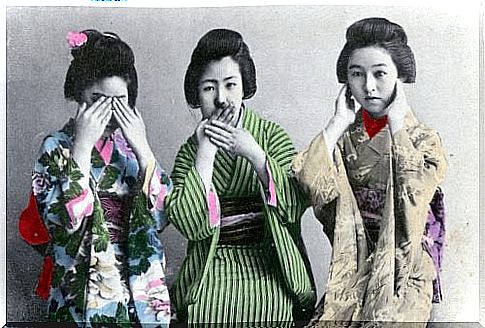The Real, Fascinating Teaching Of The “Three Wise Monkeys”

The classic story of the three wise monkeys of the Toshogu Shrine contains a simple, timeless teaching: we must be careful what we say, hear, and see.
This famous shrine is located in Japan. The monkey sculptures, one covering his mouth, the other his eyes and the third his ears, date from 1636.
Few images have crossed so many boundaries and lasted as many decades as this. Now the three wise monkeys are the icon.
Over time, however, their significance has gradually disappeared. For example, the Japanese refer to a philosophical precautionary approach:
This teaching comes from the writings of Confucius. Many think it exudes a feeling of “surrender”. However, historians see a connection between the three wise monkeys and the triple filter of Socrates.
In this way, this iconic image can serve as a much more useful message in our modern lives. The picture has nothing to do with ancient Oriental slavery, which was reinforced by not seeing or hearing injustice.
We invite you to consider these teachings.
Socrates triple filter test
To understand the similarity between the three wise monkeys and the triple filter of Socrates, it is helpful to first understand one story and teaching:
The student came to inform Socrates that someone had criticized this.
Before the nervous student even had time to open his mouth, Socrates asked him the following three questions. These are the three filters a student had to consider before speaking to Socrates:
- Truth Filter: Is what you are going to tell, sure, true? Have you ensured this carefully and moderately?
- Goodness filter: Is what you are going to say good and kind?
- Utility Filter: Is what you plan to tell us useful? Is it useful or necessary for me to tell it?
These three filters serve as guides to help us be more thoughtful, cautious, and critical of what we say.
Many people see a similarity between this teaching and the three wise monkeys of the Toshogu Shrine.
The teaching of the three wise monkeys
Let’s take a closer look at this famous picture.

Monkey covering his mouth: Iwazaru
Iwazaru is the little monkey visible on the left. To the Japanese philosopher, it represents the need not to spread evil. It is even combined with a recommendation not to express one’s own dissatisfaction or negative feelings.
Also, be careful not to let your own feelings show up too much. It’s about staying together and self-restraint.
As for its compatibility with the Socrates triple filter, it has a lot to do with the importance of avoiding gossip. This is because gossip is not always true. They are not a good thing and it is not always necessary to say them out loud.
Monkey covering his ears : Kikazaru

Kikazaru is a monkey in the middle.
In Japan, people who spread gossip, criticism and bad news are treated very negatively. Thus, the Japanese believe that it is better to cover their ears with certain types of news in order to maintain the balance of the ears.
This traditional idea might sound a little shocking here in the Western world. After all, you hear bad news, gossip and criticism here constantly and everywhere. However, if we apply the Socrates triple filter to this, we can see slightly different meanings in it:
Sometimes bad news needs to be heard because it is helpful. As an example: you tell your boss that his customers are not happy and he should work to keep these.
However, if the information is not useful and is also harmful, it is time to follow the teaching of the Kikazaru monkey: cover your mouth.
Monkey covering his eyes : Mizaru

According to the santain of philosophical and moral rule , it is better not to see, hear, or talk about injustice. As we know, this idea does not last in real life.
But if we look at the image of the third monkey through the triple filter of Socrates, we realize something. It is a direct call to close our eyes to things that are not helpful or good.
Close your eyes from the darkness to raise your gaze toward a brighter, more hopeful, and more meaningful side.









